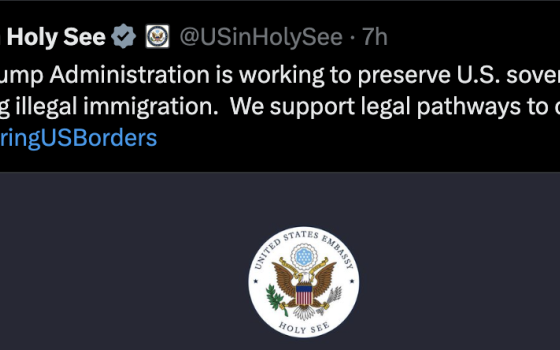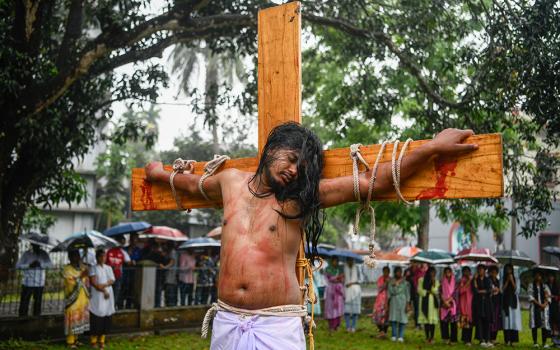
Part One of Two parts
To this day, I'm no good at math. I blame Vatican II.
In the spring of 1968, I was in fifth grade at Immaculate Conception Grammar School on Gun Hill Road in The Bronx. I was struggling with long division, as taught by the "New Math" imposed back then on all junior high school students. With "New Math," it was not good enough to get the answer right -- you also had to utterly understand the theory behind the answer. In fact, it was better to get the theory right and the actual answer wrong.
That was, by happenstance, also a very Roman-Catholic-church-way-of-thinking about nearly everything. It was an outlook that served the church well for hundreds of years -- until suddenly, with Vatican II, it did not. And in 1968, in the spring, Vatican II came to my working-class neighborhood in The Bronx. It would change my church and it would change me. Ultimately, it would keep us together.
When the bell rang for math on this particular morning, the classroom door swung open and all of us pulled up short at the entryway. The huge blackboard -- usually covered with numbers, lines and symbols meant to make me cry -- was instead filled with lyrics. They began:
I've come to talk to you again …
I looked past the blackboard and saw my math teacher, Sr. Richard, leaning against the edge of her blocky metal desk, worn guitar laid across her lap, a woven strap of rainbow colors sitting around her neck against her black nun's habit. She was tall, lanky, and only ten years older than we were. Sister smiled and said: "I thought we'd try something different today."
I raced for my desk and eagerly did not pull my math book out. For several lessons after that, the book stayed away as we learned songs by Simon & Garfunkel, Bob Dylan and Joni Mitchell. It was the first time in my life someone had waved off the rules and said: forget all that, this is what really matters. And person who said that was a nun.
***
Sr. Richard's guitar, those songs -- all my memories, really, of coming of age at my parish in an Italian blue-collar neighborhood during the 60s -- seem to be at the real heart of discussions within the church about what Vatican II was all about. Much of the debate now circling Vatican II comes from people who have backgrounds like mine -- or claim sympathies with people who have backgrounds like mine. They are traditionalists who say Vatican II confused the average working-class-person-in-the-pew, and drove us away with too many changes, too fast.
But that's not what happened to me in the Bronx.
By complete chance, I spent my boyhood and adolescence at an absolutely average church and school that somehow got caught up in the changes inspired by the Second Vatican Council. My mother still calls them "those crazy years when you were kids" -- but thanks to those years, I remain a Catholic. In the decades since, I have never met a lapsed Catholic my age who left the church because she had to hear the Mass in English, or because some guitar-playing nun force-fed him folk songs. Instead, their childhoods were usually filled with bitter memories of a much more medieval and unresponsive church -- mother superiors who smacked them, cruel priests who looked down upon them, and a church that often seemed plainly indifferent to their existence. (And as many victims will tell you, sexual abuse by priests did not suddenly begin when bishops booked their Council flights to Rome in 1962.)
I judge that era and its legacy by what it was like in the years right before and after the Council at my parish, a very blue-collar place. Theologians, liturgical scholars and students of Aramaic were nowhere to be found at Immaculate Conception. My Dad was a baker; my best friend's father managed an equipment shop for bowlers. Dreaming of being a policeman was aiming high, because it was a steady job with good benefits and an early retirement. These were the people supposedly frightened by a church in transition.
***
Immaculate Conception parish was established in 1903 by Italian immigrants settling in The Bronx. Its huge Romanesque-style church, completed in 1925, soared high enough to fit two balconies, wide enough for two side chapels, and was lit in daytime only by streaks of sunlight struggling to break through tall stained glass windows featuring faces of the saints. In its dome far overhead was a painted vision of Mary, surrounded by angels, the Holy Spirit above her, heroes from the Old and New Testaments just below.
I was in third grade when I started as an altar boy. (This would have been 1964-65, just before the work of the Second Vatican Council started to find its way into ordinary churches.) When I first stepped out onto the altar at age eight to practice my role in the Mass, I stared at up Mary-in-the-Dome, down the endless rows of empty mud-brown wooden pews -- and cracked my small knuckles nervously. The view felt like God: distant, wide, cold, and blue.
That distance from God was reinforced at the baroque altar: the priest faced away from the congregation, of course, and muttered Mass to himself. I recited prayers and responses from a laminated card printed in Latin. My favorite altar boy contribution was ringing a small sets of bells, as the priest held up the body and blood of Christ -- it was one of the few times I understood what was going on.
No one else seemed to pay full attention, anyway. My mother would rush me to church before school began, so I could serve at the eight o'clock daily Mass. In the pews were about fifty old ladies in long black peasant dresses and black veils, each with a dark rosary in her hands, shiny from years of rubbing, counting and recitation. They never stopped their own prayers during Mass -- the priest and altar boys were just a backdrop to their individual devotions. The "active congregation" that evangelicals and many other Protestants took as a given was rarely present.
My mother often sat among the ladies in black to watch me serve, standing out from the pack in her pastel colors. She stayed to pray, I always thought, for my older brother Albert, who was brain-injured during a very difficult birth and suffers from mental retardation and cerebral palsy. Despite her pastels, my mother seemed as caught up in her own cares as the others.
On Sunday, it was pretty much the same thing, albeit in front of a much larger crowd with a better demographic. But no one objected -- it only took about 45 minutes, and then we could run to the pastry shop on White Plains Road to buy a box of crumb buns for breakfast. (We'd be starving right after Mass -- you had to fast all morning beforehand, or you couldn't take communion. As Sr. Claire put it to me in second grade: Jesus doesn't want to float around inside you next to crumb buns.)
School had the same atmosphere. We were taught by the Pallotine nuns, who made up about eighty percent of the faculty. They wore severe habits that brushed the floor at the bottom, and covered everything on top except a small oval for chins, eyes, nose and just a fraction of forehead. Quiet listening was encouraged. Questions were not.
Then, somewhere inside the academic year of 1965-66, change began.
***
The decisions made in Rome finally began to reach The Bronx: Latin was out in church; English or Italian was in. Soon enough, the altar got turned around to face the pews, and a bit later we stopped kneeling at the long, marble communion railing to receive the Eucharist by mouth.
Forty years later, much of this still annoys the Catholic traditionalist wing, but none of this was shocking to me at the time. I did not feel suddenly let loose in a world where change left me dazed and depressed. For me, at age nine, church now seemed much less mysterious. I could finally understand what the Mass was about, and hearing priests speak English made them seem more like other adults I encountered, those who didn't go about their work in ancient tongues.
But here's the really odd thing: most parents (not all, to be sure, but most) liked this, too. Because most parents in my neighborhood were going through changes of their own.
During the 1960s at Immaculate Conception, a particular group of adults stepped to the forefront: second-generation Italian-Americans, eager now to stress the "American" side of the hyphen and make their own mark in the mainstream.
For my grandparents, coming to the U.S. was a traumatic event, forced on them by the rural poverty of Southern Italy. To cope, they moved into a Bronx neighborhood populated by families from their old hometown; everyone spoke the same dialect and carried with them shared connections that went back generations. The Italian-style church down the street was one more way to retreat into the familiar.
 But my parent's generation was anxious to join the American majority: they dropped their accents, gave their children English versions of Italian names (Joseph, not Giuseppe), and focused on obtaining outward symbols of American acceptance. When my father bought a forest-green 1967 Chrysler Town & Country station wagon, it was an event on my street. Neighbors tossed pennies on to the plush carpeting for good luck.
But my parent's generation was anxious to join the American majority: they dropped their accents, gave their children English versions of Italian names (Joseph, not Giuseppe), and focused on obtaining outward symbols of American acceptance. When my father bought a forest-green 1967 Chrysler Town & Country station wagon, it was an event on my street. Neighbors tossed pennies on to the plush carpeting for good luck.
The Roman Catholic church, it seemed, was in that Chrysler with us. One of the central principles of the Second Vatican Council was an elevation of the laity -- Vatican II sought to place rank-and-file members of the church on the same plane as priests and nuns. For Protestants, this was nothing new: Martin Luther had written of the "priesthood of all believers" 450 years earlier. But for Roman Catholics, it marked the creation of spiritual democracy, where each member of the church body was as important as the next. It made church feel, somehow, more American.
*****
That democracy, that de-mystification, traditionalists now argue, took away a lot of what was special about being a priest or a nun -- made it less attractive as a life choice for the sons and daughters of poor or blue collar families. Partly as a result, they assert, we have the current vocational crisis.
And yet -- my parish in the 1960s actually experienced a strong influx of young priests and nuns. While others of their generation were joining the Peace Corps or becoming Vista volunteers for the inner city, these religious brought the same energy and spirit to a parish where many struggled. (When school tuition in 1967 was raised from six dollars a month to ten, many parents worried they couldn't handle it.) The new clergy were eager to make the church and school more accessible, to make themselves more accessible. It wasn't a negative, not to the people in my parish. (As you'll see later, in fact, it wasn't enough.)
[Editor's Note: Read Part Two of this essay.]
Joe Ferullo lives in Los Angeles and works in the television industry. He blogs for NCR at NCR Today.


